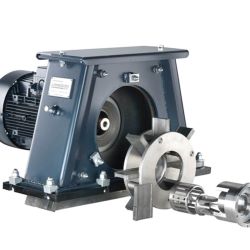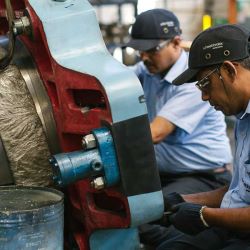Keeping up with complexities: blasting 3D-printed parts
Surfaces are getting more complex. We’ve adapted to that, developing blast and peening technology that can cope with internal surfaces and organic external topographies. But things are about to get more fiendish still.
At first, it was lightweight design that turned engine blocks into something akin to Swiss cheese – with bores, channels, nooks and crannies. Now it’s the rise of additive manufacturing (AM), the printing of (among other materials) metal parts, that is posing new challenges, adding new complexities and requiring new blast processes.
Why blast 3D-printed parts?
The additive manufacturing process itself creates its own new cleaning tasks and blast requirements. Powder residue, half sintered-on during the build process, may need removing. Additive manufacturing of metal parts can also result in a relatively rougher surface which then needs polishing.
Another important task is the removal of support structures, printed along with the part to hold it in place. Blasting is a great secondary process for this, removing the more delicate or looser supports.
3D printing processes allow the creation of fine and delicate structures on the workpiece surface directly as part of the build. These fine structures or textures would traditionally be applied after blasting, so if they are already there on the ‘raw’ part, these areas need to be masked carefully to protect them from the blast process.
Complexity inside
By far the biggest challenge from a surface technology perspective, however, is the ability to print parts with complex internal contours – creating internal part topographies that have not previously been possible.
Removing powder residue from surfaces inside incredibly complex cavities requires the latest – or still evolving – blast technology. And it’s not just the blast process itself that is challenging, the part must then also be reliably emptied of debris and blast media. This can be very tricky and has to be thought through and incorporated as part of the design process when developing the blast process for a given 3D printed part.
Blasting in nooks and crannies – the state of the art
Existing methods for internal blasting usually involve airblasting through nozzles mounted on lances that are inserted into the workpiece from the outside.
The latest advances here have resulted in flexible lance designs that emit blast media along the circumference of a very short nozzle head. This enables internal blasting around bends and corners without the risk of lances getting stuck or having to rely on rotation to cover the whole surface area.
Current short and small nozzle head designs can blast cavities of as little as 14 mm diameter. Crucially for 3D-printed parts, these cavities no longer have to have a round cross-section to be reliably covered by the blast media. This new, evolving blast method opens up new possibilities for internal blasting – not just of 3D-printed parts.
Additive Manufacturing is on the rise and any follow-on production steps have to adapt to the specific requirements of printed parts. So far, blast technology is keeping up.


